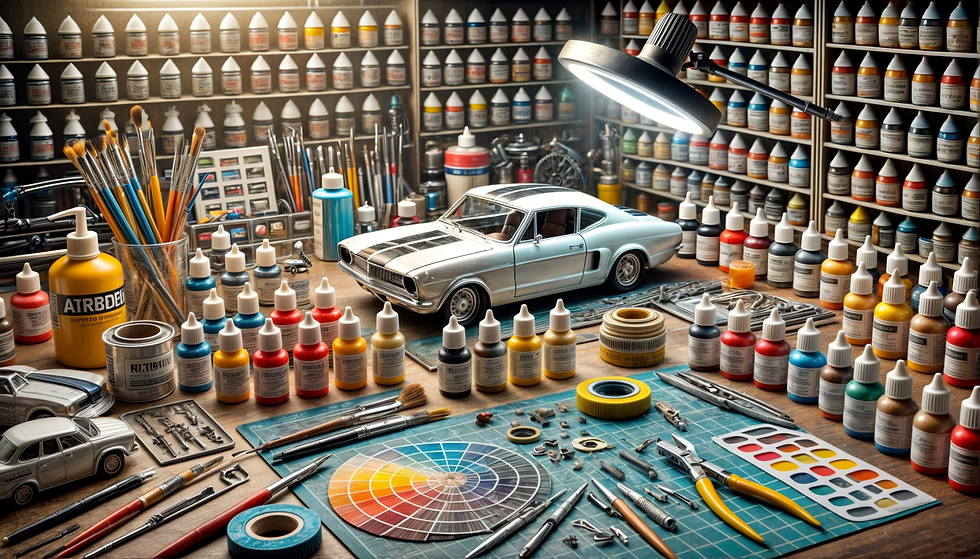Tips on Selecting the Right Tools for Painting and Customizing Diecast Car Models
- Danny Abramovich
- Jan 5
- 4 min read
Painting and customizing diecast car models can be a fun and rewarding process, especially when you have the right tools in hand. From selecting the perfect brushes to choosing an airbrush system—and ensuring you have adequate protective gear—these tips will help you make confident decisions and achieve professional-looking results.

1. Choosing the Right Brushes
a. Brush Types and Sizes
Round Brushes: Ideal for small details, script work, and painting curves. They hold more paint in the belly of the bristles, allowing for smooth application.
Flat Brushes: Good for broader strokes, base coating, and creating clean edges.
Detail Brushes: Extra-fine tips (sizes 5/0, 10/0, etc.) help you paint tiny details such as door lines, emblems, or window trims.
Tip: Invest in a variety of brush sizes so you can handle everything from large surfaces to tiny details.
b. Bristle Materials
Synthetic Brushes: Often more affordable and easier to clean. They’re suitable for use with acrylic paints and some enamels.
Natural-Hair Brushes: Usually made from sable or camel hair. They offer excellent paint retention and flow, making them popular with seasoned hobbyists.
Tip: Start with a high-quality synthetic set if you’re new to painting. You can add a few natural-hair detail brushes once you’re comfortable.
c. Care and Maintenance
Clean brushes immediately after each session using warm water (for acrylics) or specialized brush cleaners (for enamels/lacquers).
Reshape the bristles with your fingers after cleaning to maintain their sharp points.
Store them upright or flat so the bristles don’t bend.
2. Deciding Whether to Use an Airbrush
a. Benefits of an Airbrush
Smooth, Even Coverage: Airbrushing produces a smoother paint layer than most brush applications, reducing brush strokes and achieving a more professional finish.
Precision Control: You can regulate paint flow and air pressure to create subtle shading or gradients.
Efficiency: An airbrush can quickly cover entire bodies or large sections of a model without visible lines.
b. Choosing an Airbrush System
Single vs. Dual Action:
Single-action airbrushes release air and paint simultaneously, making them simpler but less versatile.
Dual-action airbrushes let you control air flow and paint flow separately, ideal for advanced techniques.
Gravity-Feed vs. Siphon-Feed:
Gravity-feed airbrushes have a paint cup on top, requiring less air pressure and providing better detail control.
Siphon-feed models draw paint from a jar beneath the airbrush and can hold more paint for larger projects.
Compressor Requirements: Look for a compressor with an adjustable pressure regulator and a moisture trap. A tank-equipped compressor can deliver a steady airflow without frequent pulsing.
Tip: If you’re new to airbrushing, consider a beginner-friendly, dual-action, gravity-feed airbrush. The learning curve is worth it once you see the smooth finishes you can achieve.
c. Maintenance and Cleaning
Always flush out leftover paint immediately to avoid clogging the nozzle.
Disassemble the airbrush periodically for thorough cleaning.
Invest in cleaning brushes or pipe cleaners to reach narrow passages in the nozzle and needle assembly.
3. Ensuring Proper Protective Gear
a. Respiratory Protection
Respirators and Masks: When working with aerosol sprays, solvent-based paints, or airbrushes, you need a mask rated for fumes and particulates. Look for an N95 or higher rating, or a respirator with organic vapor cartridges.
Ventilation: Use a spray booth or well-ventilated workspace. Even with a mask, fumes can linger in a closed environment.\
b. Eye and Skin Protection
Safety Glasses: Prevent paint splashes or dust from entering your eyes, especially when using a rotary tool or airbrush cleaning solutions.
Gloves: Nitrile or latex gloves protect your hands from chemicals, solvents, and paint residue.
c. Clothing and Work Surfaces
Wear an apron or old clothes to avoid stains.
Place a protective mat or newspaper on your workspace to catch spills and overspray.
4. Other Helpful Tools and Accessories
a. Mixing Trays and Cups
Proper paint mixing is crucial for consistent color and viscosity.
Use disposable cups or dedicated mixing palettes for easy cleanup.
b. Masking Tapes and Adhesives
High-quality masking tapes prevent paint bleeding on edges.
Look for low-tack options designed for model-making or delicate surfaces.
c. Cleaning Supplies
Microfiber Cloths: Gently remove dust from models without leaving scratches.
Brush Cleaners: Specialized solutions help maintain bristle shape and longevity.
Airbrush Cleaning Kit: Includes small brushes and needles for dislodging paint buildup in tiny openings.
d. Lighting
Invest in bright, color-accurate lighting to see details clearly and ensure paint colors appear as intended.
Desk lamps with daylight-balanced bulbs (around 5,000K–6,500K) are ideal.
5. Budgeting and Prioritizing
Start Small: If you’re new, begin with a few quality brushes and basic paints. Add more specialized tools (like an airbrush and compressor) as you get comfortable.
Upgrade Slowly: Aim for better gear over time rather than purchasing everything at once.
Learn Proper Technique: A top-of-the-line airbrush can’t compensate for poor painting technique. Practice is key to mastering any tool.
Final Thoughts
Selecting the right tools for your diecast car projects is a combination of personal preference, project complexity, and budget considerations. Brushes offer a hands-on, precise approach, while airbrushing creates sleek finishes and handles large areas quickly. Ultimately, don’t forget about your health and safety—proper protective gear and ventilation should be a top priority. When armed with these tips and quality equipment, you’ll find customizing your diecast models both enjoyable and rewarding.




Comments